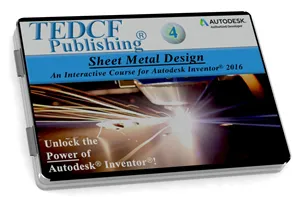More than just sheet metal!
The Inventor 2016: Sheet Metal Design course shows you how to take control over your sheet metal parts and assemblies. You'll know what you need to do to make sheet metal parts unfold properly as well as how to use all the commands. A key component to doing this is to learn how sheet metal rules and styles work.
The course starts you off with the basics and builds your skills beyond that of most users. You'll learn how to work with styles and template. You'll practice working with K-Factors and Bend Tables, and you'll learn how to setup all the settings. From simple bends to punches and multi-body modeling, this course covers everything.
You'll also learn how to use the Frame Generator. The Frame Generator can be used to build structural components that are housed in sheet metal. You'll learn how to create custom structural shapes. Publish them to the Content Center, and use them is your assemblies.
This course is packed with tips and tricks that will help you quickly and accurately build sheet metal parts and assemblies. It even comes with a K-Factor calculator.
86 Lessons (Listed Below)
9.4 hours of instruction
You can also browse through the lessons from the following Inventor 2016 courses and watch sample lessons.
Inventor 2016: Solid Modeling Inventor 2016: Assemblies and Advanced Concepts Inventor 2016: 2D Drafting and Customization Inventor 2016: Sheet Metal Design Inventor 2016: Tube and Pipe Routed Systems Inventor 2016: Inventor Studio Made Simple Inventor 2016: iLogic Made Simple Inventor 2016: Fea Made Simple Inventor 2016: Dynamic Simulation Made SimpleOur Inventor courses require No Installation. You can watch them on any device connected to the internet.
You will receive an email containing your User Name and Password. Login to your account and start learning. It's that easy.
While you're logged into your account you can download files used in the courses, watch lessons, and practice the tasks taught in the lessons. Keep in mind that you will use your installation of Inventor to practice.
Get your Inventor 2016 training now. You can start learning in minutes.
Autodesk Inventor® 2016:
Sheet Metal Design
No Installation Required
Watch from any device connected to the internet.

$59.95 - $229.95
Watch Sample Lessons
Watch the first hour of the Solid Modeling course for Autodesk Inventor 2016.
 Click to Watch!
Click to Watch!Sheet Metal Design
9.4 hours of instruction
Lessons
Introduction
The Sheet Metal Environment
Styles and Templates
K-Factors
Creating Bend Tables
The Flange Command
Bend Reliefs and Remnants
Bend and Sheet Metal Styles
Unfold Methods
Corner Seams
Corner Seam Reliefs
Bend Transitions and Flat Patterns
Custom Sheet Metal Templates
The Contour Flange Command
Looped Contour Flanges
Shells and Ripped Seams
Editing Flat Patterns
Using the Hem Command
Multiple Plates in Assemblies I
Multiple Plates in Assemblies II
Extended Surfaces
Using the Punch Tool
Custom Punches
Flat Pattern Punch Representations
Custom Extruded Louver Punch
Dangling Geometry in Punches
Custom Extruded Dimple Punch I
Custom Extruded Dimple Punch II
Custom Revolved Dimple Punch
Sheet Metal Commands and Punches
Surfaces
G2 Fillets
Tabs
Adjusting for Bend Allowances
Double Bends
Applying Bend Allowances
Knockouts
Changing Knockout Size
Define A Side Strategies
Modifying Flat Pattern Orientation
Flat Patterns on Drawings
Custom Sweep Punches
Complex Shapes
Sheet Metal Cone
Contour Roll Unrolling Unfolding
Press Break Lofted Flanges
Square to Round Transitions
Adding Flanges to Lofted Flanges
Editing with Unfold and Refold
Lofted and Rolled Part Strategies
Formed Punches and Features
Cut Across Bends
Punch Across Bends
Custom Structural Shapes I
Custom Structural Shapes II
Publishing Multiple Shapes
Frame Skeletons
Generating Custom Shape Frames I
Generating Custom Shape Frames II
Generating Custom Shape Frames III
Generating Custom Shape Frames IV
Trimming Members
Model Frame Skeletons
More Frame Generator Concepts
Editing Frames
Preparations and Welds
Fillet and Post Weld Operations
Multi-Body Sheet Metal Modeling
Features on Multi-Body Sheets
Multi-Body Sheet Metal Bends
More Multi-Body Practice
Multi-Body Sheet Metal Assembly
Modifying Multi-Body Components
Finalizing the Design
Convert to Sheet Metal Parts
Sheet Metal Drawings
Export Flat Pattern to DXF
Custom Exported Layers
Details of Exported DXF Files
Converting Down Bends to Up Bends
Edit Flat Pattern Definition
Bend Callouts and Tables
Bend Order
Flat Pattern Extents
Compare Drawing to DXF
Conclusion
